Ijraset Journal For Research in Applied Science and Engineering Technology
- Home / Ijraset
- On This Page
- Abstract
- Introduction
- Conclusion
- References
- Copyright
Activity Overlapping Technique for Early Completion of Construction Project
Authors: Deependra Gour, B. P. Mudgal
DOI Link: https://doi.org/10.22214/ijraset.2022.44091
Certificate: View Certificate
Abstract
An effective and well-known method for the early completion of construction projects is the overlap of the project’s critical activities or phases that would normally be carried out in sequence. The overlapping technique reduces the project completion time with a minimum cost overrun. Overlapping is also called a fast-tracking mechanism. It is risky because it increases the probability of rework resulting in increasing the cost of the project. The Overlapping in construction projects must be carried out effectively because each pair of activities cannot overlap, since some previous activities may not allow overlap due to maximum rework. Various overlapping strategies exist in a construction project which all can result in time-saving. so, the cost of these strategies varies significantly depending on the overall Rework. A favorable overlapping strategy leads to minimal time savings costs. To find such a strategy, the question arises: “Which activities have to be overlapped and to what extent to reduce the project duration at the minimum cost?” This study addresses the question and generates an Overlapping Decision algorithm.
Introduction
I. INTRODUCTION
To complete any project on the proposed duration all the resources including human resources, material resources, machinery, and budgeted costs must be used efficiently.
That is the main responsibility of the project management team. In a construction project, these resources along with duration play a vital role. The overall growth and success of any project are directly or indirectly dependent on time. The project duration is estimated by the addition of individual critical activity duration of the entire project i.e., the duration required to execute these given activities.
This project duration can also be further decreased by the skills of the project manager as well as the use of modern techniques. Many Infrastructure projects rely on the schedule techniques which are capable of completing the project in a given time frame. Earlier practices involve crashing, substitution which requires additional resources to be deployed and involves many calculations which become tedious, but the overlapping does not require any additional resources. The overlapping is also defined as the Fast-tracking mechanism of project execution. It is an important aspect of concurrent engineering which allows a methodology to reduce the project delivery time.
This fast-tracking mechanism allows for delivering the project before its duration which increases the chances of new opportunities for the project team.
II. OVERLAPPING
Overlapping is a phenomenon in which two activities are executed simultaneously, for example, construction can start before the design is finalized by taking some assumptions by technical skills. Thus, design and construction can start altogether, if there is a chance of error in doing so, then that error is defined as Rework. Rework is particularly an adopted value in a construction project which generally varies from 15-20% that the project practitioner should handle efficiently.
III. OBJECTIVE
- This research develops an Overlapping Decision algorithm to solve the question of when to overlap, how much to overlap, and what strategy to use to achieve the overlapping when the objective is to reduce the project schedule while minimizing cost increases.
- In this research, MS Project is used for Project activity scheduling.
IV. LITERATURE REVIEW
- Krishnan et al. (1995) defined the application of Overlapping in product development and reduction of product delivery time.
- Peña-Mora and Li (2001) provided an approach to dynamic planning in concurrent engineering by using GERT to develop a fast-track mechanism.
- Bogus et al. (2005) considered overlapping simulation technique is provided by which
classified the activity in two stages i.e., upstream and downstream, and characterized the activity into four types Slow Evolution (SE), Fast Evolution (FE), Slow Sensitive (SS), and Fast Sensitive (FS). He provided a simulation model and found a reliable approach to modelling concurrent engineering activities which is a useful methodology to estimate risk generation and strategies for overlapping. The construction project is executed by breaking into a small packet of work defined as the activity, which can further be on the basis of dependency and relation among them.
4. Bogus et al. (2006) provide the methodology of overlapping dependent activities which may sometime lead to errors causing rework which has to be assessed by a proper approach. One such approach is given by Lee et al. (2006).
5. Blacud et al. (2009) analysed the sensitivity of construction activities, to interrelate activities through semi-structured interviews and provided factors and assessing activity's sensitivity to avoid risks during overlapping.
6. Dehghan et al. (2010), the concept of assessment of overlapping in oil and gas projects.
7. Dehghan and Ruwnapura (2013) established an interrelationship between overlapping and rework and provided the formula for rework and the amount of overlapping. The overlapping has become necessary for the research team to complete the project before the estimated duration as it is beneficial in many aspects because it increases the prestige of the construction company and increases the new opportunities and develops confidence among the project team. This research is used to evaluate the criteria of any construction project during the overlapping. The criteria adopted in this study remain the same for every construction project. These criteria are the result of the overlapping of activities. Game theory is used to analyze engineering problems by forming a matrix. This game matrix is a two-person zero-sum game established by (Peldschus, 2005), where player-I strategy is related to variant and player-II strategy is related to criteria. Each criterion is associated with different dimensions, these criteria are transformed into dimensionless numbers on the interval [0,1] by adopting the transformation method given by (Peldschus, 2008; Ginevi?ius, 2008). The overall strategy will provide a methodology for the project team to determine the extent of overlapping of activity and the result of the overlapping of activity and find the optimal duration with maximum advantage.
8. Lee et al. (2006) discussed dependability and stability in construction projects and described the benefits of overlapping.
9. Bogus et al. (2011) developed the methodology to classify the up and downstream activity to recognize the potential of rework risk by simulation techniques.
10. Gwak et al. (2016) used the exact time cost trade-off to measure the rework cost slope which was incurred due to overlapping activity.
11. Francis (2016) shows the uncertainties of overlapping in construction projects and measures them by Monte-Carlo Simulation. The practice of overlapping was being applied first for manufacturing and commercial application but now overlapping has acquired its own place in various construction and infrastructure project. A known practice for speeding up construction projects is to overlap activities in the design phase. There are various critical activities exist in the design phase.
V. OVERLAPPING: A TOOL FOR CONSTRUCTION MANAGEMENT
The construction project operation is completed in three stages i.e., Design-Construction-Delivery. Further to accomplish a task in a specific manner the project is breakdown into smaller tasks, these tasks are called activities. The stepwise completion of this activity leads to project finish in the estimated duration, i.e., an approach of the traditional method but the fast-tracking or overlapping mechanism is related to the execution of two activities simultaneously and the activities which are performed at the same time are called parallel activities.
The activities are defined in two ways:
- Predecessor Activity- The activity which finishes prior to the start of any activity is called predecessor activity.
- Successor Activity- The activity which starts after the finish of any activity is called successor activity.
To relate these activities with each other a network diagram is drawn, and a critical path is chosen, which has maximum duration, and activities of this critical path are called critical activities. These critical activities are mainly responsible for project delay and cost escalation. If the executions of these critical activities are handled with proper supervision and carefully then the project accomplishment would be better.
The overlapping is the tool with which these critical activities will be completed in a lesser duration which is the main demand of the project management team. The degree of overlapping is depended upon the activity relationship. There exist 4 types of activity relationships as shown in Fig-1. From the Fig-1 relationship (Independent and Interdependent) type relationship can be overlapped to any extent as there is no dependency, while dependent and semi-dependent type relationship activities overlapping are limited.
VI. ACTIVITY RELATIONSHIPS
There are four types of activities relationships -
- Dependent Activities: In order to start, one activity requires the last data from another activity.
- Semi-independent Activities: To start, one activity requires only partial information from other activities.
- Independent Activities: No information dependence exists between the two activities.
- Interdependent Activities: The exchange of information in two ways between activities takes place until it is completed.
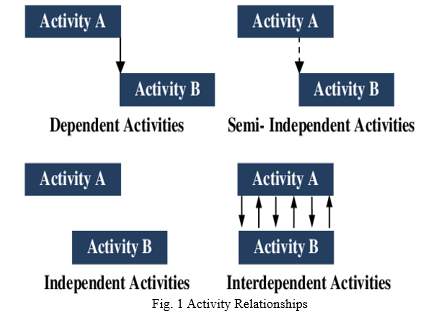
VII. EVOLUTION AND SENSITIVITY
Evolution defines the rate at which plan data is produced from the beginning of action through the completion of the activity. The range of evolution can be "fast" or "slow".
The Sensitivity is depending on the activity evaluation. if evaluation of activity is fast then sensitivity is low and if evaluation of activity is slow then sensitivity is High. So, activity evaluation is the main cause of sensitivity “low” or “high”.
VIII. DECISION-MAKING ALGORITHMS
- Find the critical path of the project’s activities in a non-overlapping schedule.
- Find the evolution and sensitivity characteristics of each activity on the critical path.
- For each potential overlapping strategy (for each asset pair), compute the daily cost (or another appropriate time measure) of the overlapping.
- Calculate the overlap duration of each activity’s pairs.
- Calculate the probability of rework of overlapped activity pairs.
- Calculate the rework duration of overlap activity pairs.
- Calculate the rework cost of overlapped activity pairs.
- Calculate the Time-saving of overlapped activity pairs.
- For each activity pair, select a strategy with a range of values ??that lead to minimal cost growth.
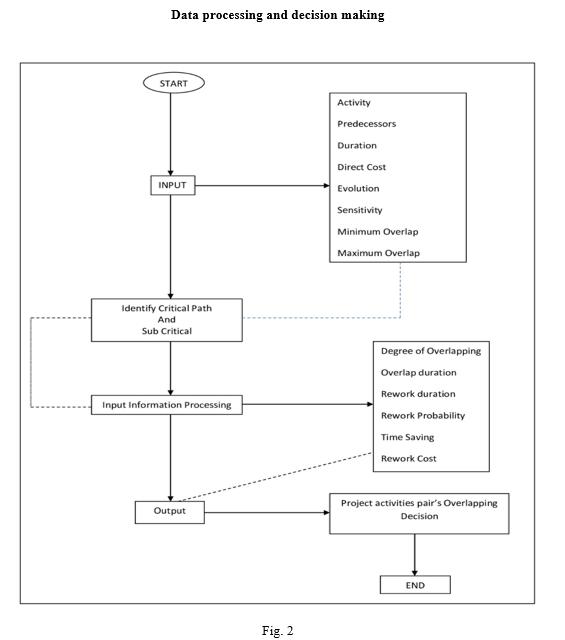

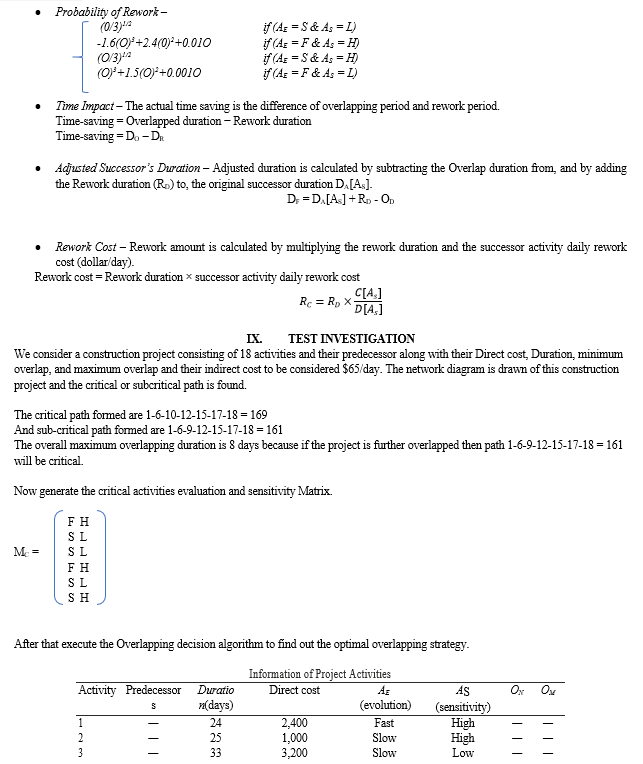
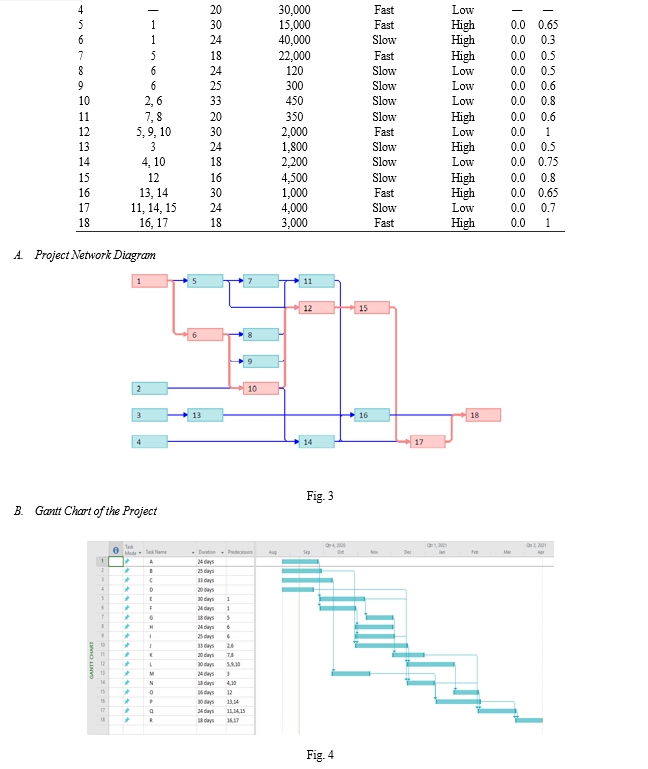
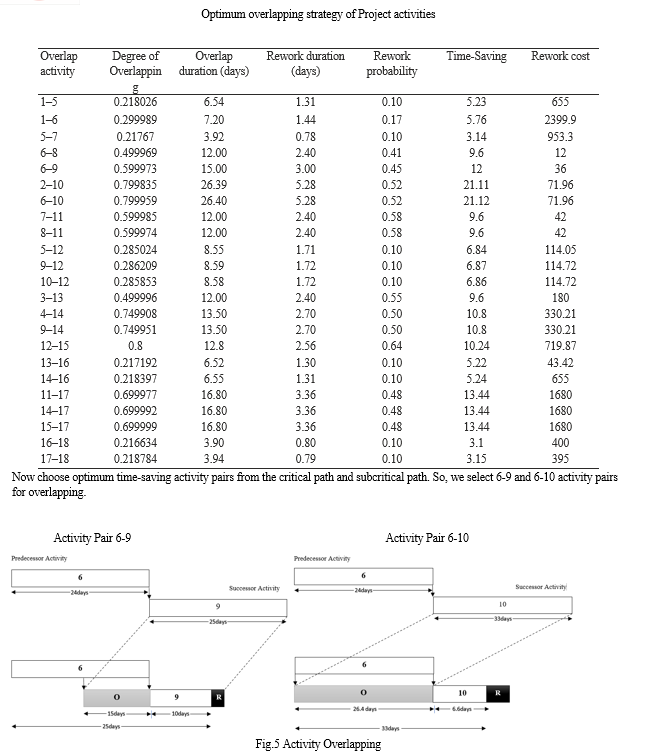

Conclusion
This research highlights the overlapping mechanism of project activities by taking pairwise critical activities and overlapping them by incremental duration up to the extent that any other path does not become a critical path. This has to be remembered because the formation of the more critical path can make the problem tedious. This overlapping concept is related to the activity relationship which has to be taken into effect. The time and cost impact of overlapping is also reviewed on the project schedule and cost reduction and optimum overlapping benefits by these activities pair are found. The obtained result will be used fully for project practitioners to efficiently overlap the project activity and adopt the fast -tracking mechanism of the project in order to reduce cost and schedule.
References
[1] Blacud, N. A., Bogus, S. M., Diekmann, J. E., & Molenaar, K. R. (2009). Sensitivity of construction activities under design uncertainty. Journal of Construction Engineering and Management, 135(3), 199-206. https://doi.org/10.1061/(ASCE)0733-9364(2009)135:3(199) [2] Bogus, S. M., Diekmann, J. E., Molenaar, K. R., Harper,C., Patil, S., & Lee, J. S. (2011). Simulation of overlapping design activities in concurrent engineering. Journal of Construction Engineering and Management, 137(11), 950-957. https://doi.org/10.1061/(A SCE)CO.1943-7862.0000 363 [3] Bogus, S. M., Molenaar, K. R., & Diekmann, J. E. (2005). Concurrent engineering approach to reducing design delivery time. Journal of construction engineering and management, 131(11), 1179-1185. https://doi.org/10.1061/(ASCE)0733 9364(2005) 131:11(1179) [4] Bogus, S. M., Molenaar, K. R., & Diekmann, J. E. (2006). Strategies for overlapping dependent design activities. Construction Management and Economics, 24(8), 829-837. https://doi.org/10.1080/01446190600658529 [5] Dehghan, R., & Ruwnapura, J. Y. (2013). Model of trade-off between overlapping and rework of design activities. Journal of Construction Engineering and Management, 140(2), 113. https://doi.org/10.1061/(ASCE)CO.1943-7862. 0000786 [6] Dehghan, R., Ruwanpura, J. Y., & Khoramshahi, F. (2010). Activity Overlapping Assessment in Construction, Oil, and Gas Projects. In Construction Research Congress2010: Innovation for Reshaping Construction Practice (pp.1175-1184). https://doi.org/10.1061/41109(373)118 [7] Francis, A. (2016). Simulating uncertainties in construction projects with chrono graphical scheduling logic. Journal of Construction Engineering and Management, 143(1), 1-14. https://doi.org/10.1061/(ASCE)CO.1943-7862.0001212 [8] Ginevi?ius, R. (2008). Normalization of quantities of various dimensions. Journal of business economics and management, 9(1), 79-86. https://doi.org/10.3846/1611-1699.2008.9.79-86 [9] Gwak, H. S., Son, S. H., Park, Y. J., & Lee, D. E. (2016). Exact time–cost tradeoff analysis in concurrency-based scheduling. Journal of Construction Engineering and Management, 142(10), 1-13. https://doi.org/10.1061/(ASCE)CO.1943-7862.0001164 [10] Krishnan, V., Eppinger, S. D., & Whitney, D. E. (1995). Accelerating product development by the exchange of preliminary product design information. Journal of Mechanical Design, 117(4), 491-498. https://doi.org/10.1115/1.2826709 [11] Lee, S., Peña-Mora, F., & Park, M. (2006). Reliability and stability buffering approach: Focusing on the issues of errors and changes in concurrent design and construction projects. Journal of construction engineering and management, 132(5), 452-464. https://doi.org/10.1061/(ASCE)0733-9364(2006)132:5(452) [12] Peldschus, F. (2005). Multiple?criteria analysis in the construction of motorways. Technological and Economic Development of Economy, 11(1), 32-35. https://doi.org/10.1080/13928619.2005.9637680 [13] Peldschus, F. (2008). Experience of the game theory application in construction management. Technological and Economic Development of Economy, 14(4), 531-545. https://doi.org/10.3846/1392-8619.2008.14.531-545 [14] Peña-Mora, F., & Li, M. (2001). Dynamic planning and control methodology for design/build fast-track construction projects. Journal of construction engineering and management, 127(1), 1-17. https://doi.org/10.1061/(ASCE)0733-9364(2001)127:1(1)
Copyright
Copyright © 2022 Deependra Gour, B. P. Mudgal. This is an open access article distributed under the Creative Commons Attribution License, which permits unrestricted use, distribution, and reproduction in any medium, provided the original work is properly cited.

Download Paper
Paper Id : IJRASET44091
Publish Date : 2022-06-11
ISSN : 2321-9653
Publisher Name : IJRASET
DOI Link : Click Here
 Submit Paper Online
Submit Paper Online

